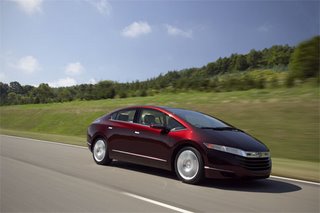WEB EXCLUSIVE Hydrogen

There’s something disconcerting about driving a high-speed oval for the first time, and it’s easy to identify: As you approach either of the steeply banked turns, you don't slow down. Trust me when I tell you it’s easier to nod and say “Sure, I get it” than it is to blast into those perfect semicircles at full speed. Especially when you’re only the second civilian in the world to drive the next-generation Honda FCX prototype, a one-of-a-kind, multimillion-dollar, zero-emission fuel-cell car that you always assumed was made of duct tape and posterboard gussied up with a nice paint job, as is so often the case for auto-show concepts. Surely the rules are different for this car.
“Dondon dondon osaete kudasai.” Huh? I mentally check and then recheck my Japanese. There’s no question: The clipboard-clutching engineer next to me just told me to floor it. So I floor it. And the car goes—fast. Though Honda will not give official numbers for acceleration, my silent mental stopwatch puts the FCX’s 0–60 time at about seven seconds, on par with an Audi A4. And around the steep banks, the car is completely surefooted, with no shakes or scary suspension moments. It seems a lot closer to production-ready than its “limited release” date of 2008 (which refers to the year when, like, one guy in California gets to lease the car) would suggest.
The FCX's driving traits are attributable to Honda’s new vertically oriented fuel cell. Instead of lying flat under the floor like all the other hydrogen vehicles out there, Honda’s new stack stands upright where a normal car’s transmission would go. The advantage of this is that the water created as a by-product of converting hydrogen to electricity doesn’t need to be aggressively pumped out of the fuel cell; gravity does much of the work, so there’s much less need for a power-sucking, efficiency-stealing pump to move the moisture. The orientation also makes for a much lower center of gravity than a typical fuel-cell car. Almost all of the ones before the FCX looked like mini SUVs: high off the ground for their size. This is because most of the area under their floors was taken up by their fuel cells and the massive cooling ducts meant to keep them from overheating. This design made the cars nail-biters anywhere north of 75mph.At least, that’s how the currently available version of the FCX felt when I drove it for comparison. While I slowed it waaaay down before entering the curve, I pushed the low-slung prototype into the bank at more than 80 miles an hour. The high-off-the-ground ’05 FCX felt skittish even on the straightaway at its maximum speed of 140 kph (about 87 mph). The FCX prototype, which looks like a sleeker and more stylish Accord, is low to the ground, sporty, and well-behaved at 92 mph, my maximum speed in it.
WEB EXCLUSIVE Hydrogen

0 Comments:
Post a Comment
<< Home